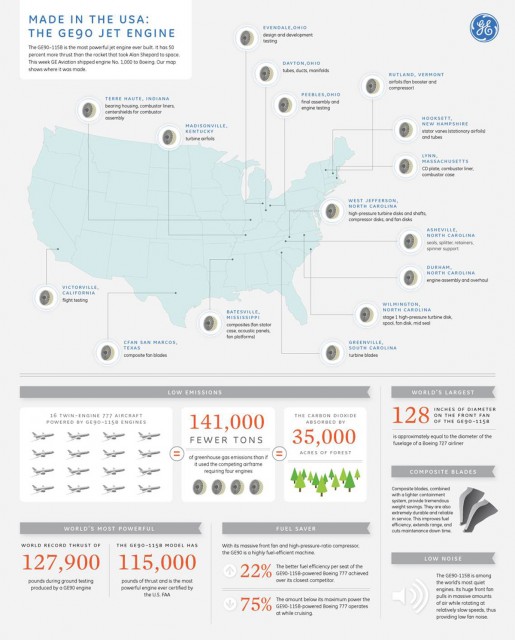A little over a year ago, on March 20, 2011, the Boeing 747-8 Intercontinental had her first flight. This video from Boeing highlights how the 747 has revolutionized long-haul flight and how they hope that the Intercontinental continues that tradition.
Japan Airlines (JAL) announced today that they plan to take official delivery of their first 787 Dreamliner this Sunday, March 25th, with a delivery ceremony to follow on the 26th. The aircraft is then scheduled to take off from Paine Field at about 4pm local time on Monday to head to Narita in Tokyo with JAL pilots at the controls.
The airline plans to start operating their first Dreamliner on their new Boston to Tokyo route, currently scheduled to start on April 22, 2012. JAL has also announced the intention of starting 787 service between San Diego and Tokyo later in the year.

HI RES IMAGE (click for larger). Executive Class cabin on JAL's first Boeing 787 Dreamliner. Photo by Boeing.
JAL becomes the second airline to take delivery of a 787, but this aircraft will represent a few firsts: It will be the first one to be delivered with GEnx engines, the first to be commercially fly a route to the US and the first to be used on a brand new route (ANA’s 787s have replaced other aircraft on routes that already existed).
The first aircraft is configured in a two class layout, with 42 seats in business class and 144 seats in economy.

HI RES IMAGE (click for larger). The economy cabin inside JAL's first Boeing 787 Dreamliner. Photo by Boeing.
The business (or executive) class seats are in a 2-2-2 layout and provide about 60″ of seat pitch and a bit over 21″ of width. The seat will recline to about 171 degrees. The Economy class is configured in a 2-4-2 layout and will provide 31″ seat pitch and 18.5″ seat width.

HI RES IMAGE (click for larger). JAL's Boeing 787 Dreamliner taking off at Paine Field. Photo by Boeing.
JAL’s new in-flight entertainment system, called SKY MANGA, will also debut on the aircraft. The interior has a very different looking atmosphere than ANA’s Dreamliner cabin.
Screen shot of Boeing's flight tracker. Every dot represents a Boeing aircraft in flight. Click to make a visit.
At any given time there are tons (literally) of Boeing aircraft that are flying around the world. Recently, Boeing placed a flight tracker program on their newairplane.com website that let’s you get an idea just how many planes there really are.
The site does not show live flights, but instead uses data from the Official Airline Guide (OAG), which is run on a monthly basis. This flight tracker shown on the website is similar to one found in the Boeing Dreamliner Gallery. However, the one in the gallery is able to show an airline customer just their Boeing flying around the globe.
On the site, you are able to see flights operated by a 737, 747, 767, 777 or all of the above. So why not the 787 or 757? Boeing explained to AirlineReporter.com that since the 757 is no longer in production, they decided not to add it and that they plan to add the 787 in the future. Currently the Dreamliner is missing, since there just were not any commercial 787 flights when the program went live.
It is really interesting seeing the different routes that are flown through out the day by different aircraft types. Are there any that really stick out to you?
Thanks to Gordon for pointing this one out!
Air Tahiti Nui is a small airline based out of Faa’a International Airport in Papeete, Tahiti. They operated a fleet of only five Airbus A340-300 aircraft that are set up in a three class configuration. Each one of the aircraft has a unique name of one of the local islands: Bora Bora (F-OJTN), Mangereva (F-OJGF), Rangiroa (F-OSEA), Moorea (F-OSUN) and Nuku Hiva (F-OLOV). The airline was created to increase tourism and operations commenced on November 20, 1998.
Air Tahiti Nui’s livery is one that definitly stands out and I think in a nice way. The blues match the waters of Tahiti and the red stripping matches the flag of French Polynesia.
The General Electric GE90 engine is one amazing piece of machinery used on Boeing 777s around the world. According to GE Reports, the engine holds the Guinness Book of World Records for generating the most thrust at 127,900 pounds.
Not too shabby, considering that the Redstone rocket that took the first American, Alan Shepard, to space had just 78,000 pounds of thrust. I fact, if you need to combine the thrust of all EIGHT engines of a B-52 Stratofortress to get 136,000 pounds to beat the GE90.
The GE90 engine started commercial service on a British Airways Boeing 777 on November 12, 1995. More recently, GE celebrated the production of the 1000th GE90 and made this info-graphic to not only show part of the process the engine went through, but also some interesting facts about the engine.
One of the most impressive parts of the engine is the shape of each fan blade. You can actually find one on display at New Yorks’ Architecture and Design Collection at the Museum of Modern Art — how many other airliner parts can say that?


